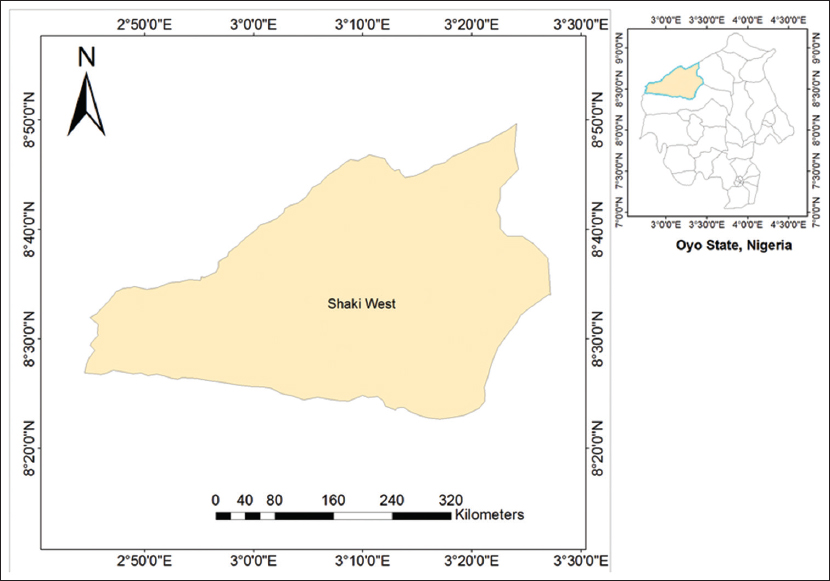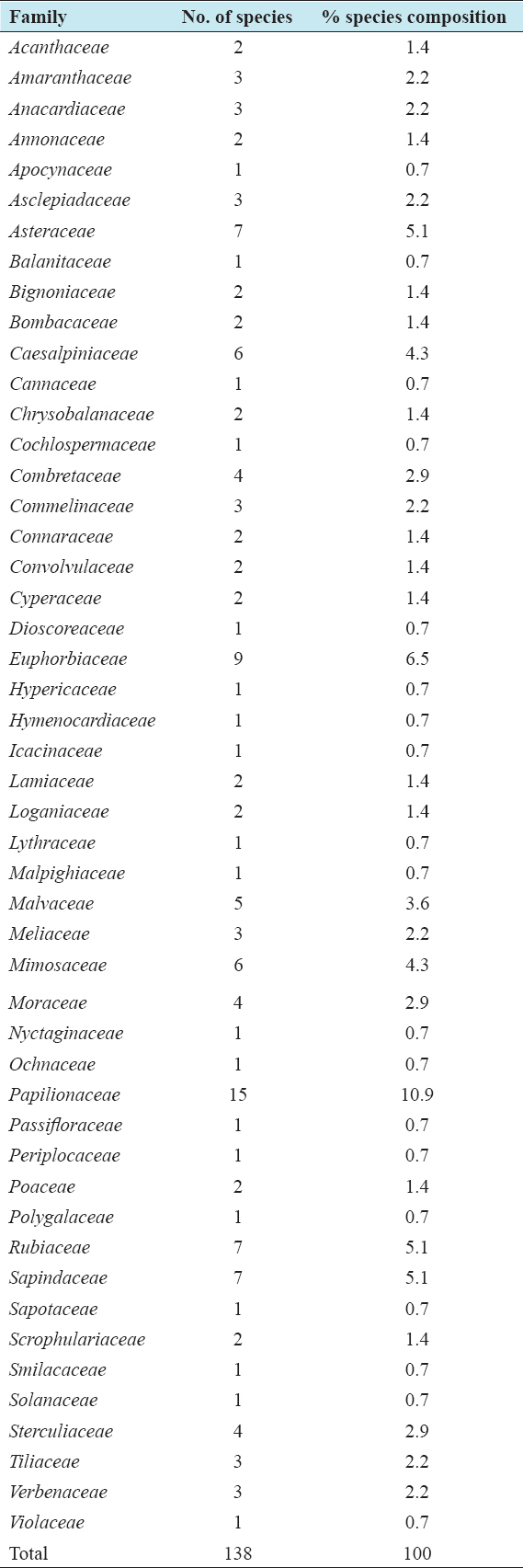INTRODUCTION
Biodiversity assessment has remained an important discussion among scientists around the world, and the West African forests are among the most important biodiversity hotspots in the world as noted by Mittermeier et al.[1] Scholes and Archer[2] put it clear that the World’s land surface is covered by savanna vegetation. Studies have shown that composition and structure of an ecosystem are influenced by a number of factors[3,4] and prominent among these factors are disturbances which are thought to be key aspect and the cause of local species variation within an ecosystem based on their intensity, scale, and frequency.[5] The savanna ecosystem is not different, as these areas are chiefly influenced by the availability of water, annual fire, and animal grazing.[6,7]
However, the knowledge of floristic composition and structure of an ecosystem is useful in identifying and monitoring the state of such vegetation.[8] This has become very crucial in the face of the ever-increasing threat to the forest ecosystem and eventual species extinction. According to Kimmlins,[9] we simply do not know how to recreate a species once it has become extinct. It is, therefore, wise to at least have an inventory of this our biodiversity and to make appropriate recommendation for the preservation of the species which will be large enough to encompass the local variation of genotypes and which will further ensure the survival of the angiosperm genetic diversity of an area.[10] The present study documents the flora of Wasangare community and also suggests ways to the conservation of the indigenous angiosperm genetic variability of the area.
MATERIALS AND METHODS
Study Site
The study area is located on Latitude 8°49’N and Longitude 3°25’E at the extreme of Oyo state, in Saki West Local Government area [Figure 1] with its headquarters in Saki town. The town has a resettlement center of the second mechanized division of the Nigerian Army. The site is characterized by Guinea savanna vegetation and accommodates some rain forest species. It also has a Parkia biglobosa plantation established in 1994 by the Forestry Research Institute of Nigeria.
Figure 1: Location map of study area
Species Enumeration
The survey involved repeated visits to the community for the collection of existing tracheophytes, and most of these species were identified on the field using taxonomic keys provided in Hutchinson et al.,[11] Hopkins and Stanfield,[12] Stanfield,[13] Lowe and Stanfield,[14] Lowe,[15] and Keay,[16] while others were taken to the Forest Herbarium Ibadan[17] for proper identification. The families and habits are also reported.
RESULTS AND DISCUSSION
A total of 138 plant species belonging to 49 families were identified around the community [Table 1]. These species were dominated by the legumes comprising Papilionaceae (15 species), Caesalpiniaceae (6 species), and Mimosaceae (6 species), respectively. Other dominant families include Astercaceae, Rubiaceae, and Sapindaceae with 7 species each represented while Malvaceae had 5 species. Three (3) families had 4 species represented, seven (7) families had 3 species, twelve (12) families had 2 species, whole nineteen (19) families had only 1 species represented [Table 2], thus an indication of their importance in ecosystem balancing.
Table 1: Species checklist of the study area
Table 2: Species distribution across families
In relation to the life forms or habits, the trees contributed 34% of the total enumeration. Others were the shrubs, herbs, and climbers which had 26%, 23%, and 10%, respectively. Nevertheless, the grasses, creepers, and sedges constituted the remaining 7% of the identified flora [Figure 2].
Figure 2: Percentage distribution of species across the identified life forms
Further findings presented in Table 3 revealed that 54 species out of the total number recorded have socioeconomic importance such as food, construction activities, local medicine, cosmetics, and animal grazing within the community and adjoining villages. Aside the present report, studies had earlier documented the avalanche of species occurring in Western Nigeria,[10,18-21] thus reflecting the importance of biological assessment in our society. Nevertheless, while this aspect of science is fundamental to the conservation of biological diversity, reports by some authors[22,23] are indications that the ecosystems in Nigeria face a greater risk if urgent attention is not considered.
Table 3: Some identified socioeconomic species
Interestingly, the trees and shrubs had the highest representation across the different plant habits/life forms identified, with equal number (21). This is also the case for grass and sedge identified but with the least number recorded [Figure 3]. In furtherance, the abundance of legumes as witnessed in this study corroborated the fact that Africa has a vast array of indigenous legumes, ranging from large rainforest trees to small annual herbs, as listed in Lock.[24] However, these species are facing big threats as the study area faces several disturbances from cattle rearers and villagers in the surrounding environments who fetch the woods for firewood production. With such, it is considered that immediate economic benefits exceed those for conservation, as put by Ferraro and Kiss[25] and Kiss.[26] It is, therefore, our opinion that proper management strategies should be put in place to salvage the rich but endangered ecosystem. Provision of basic socioeconomic amenities such as electricity, schools, good roads, portable water, and hospitals[19] would be good incentives to the surrounding communities, if conservation of the area is to be well achieved.
Figure 3: Number of plant families across the life forms
CONCLUSION
This study has recorded a total of 138 angiosperms in Wasangare community. The trees and shrubs constitute the most useful of all the plant habits identified. This study has also shown the importance of biodiversity assessment and monitoring and has added to the existing records of such study in South-western Nigeria. While we cannot rule out the continuous dependence on plants for survival, it is more important to consider the sustainable collection and use of these important species, to avoid the complete disappearance of biodiversity.






